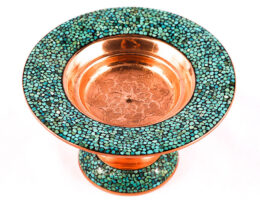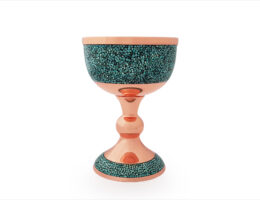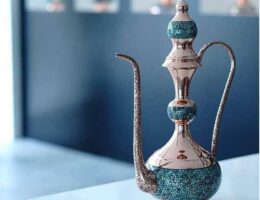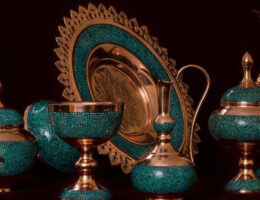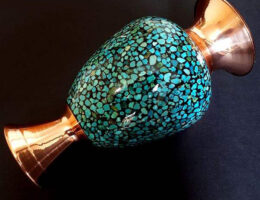IRAN ART EXHIBITION: INTRODUCING THE ART OF TURQUOISE INLAYING
HISTORY OF TURQUOISE INLAYING
The art of turquoise inlaying is one of the new arts which dates back to 70 years ago. Master Yousef Hokmian founded this art in Mashhad about 70 years ago. After that, Haj Dadash promoted the art of turquoise inlaying in Isfahan about 20 years later. Today, it is one of the most significant bases for turquoise inlaying in Isfahan.
Art of turquoise inlayer
It is a kind of handicraft and is made by putting small pieces of turquoise stone in a mosaic shape on the surface of dishes, ornaments and decorative objects (from bases made of copper, brass, silver, nickel silve or bronze). A kind of lac is placed between the turquoise pieces. The fuller and more regular the turquoise-inlayed dish is and the shorter the distance between the turquoise pieces, the greater its artistic value. Today, Isfahan is the center of this art.
TYPES OF TURQUOISE STONES IN TURQUOISE INLAYING
This stone is of two types in terms of quality and color:
• Gypsum turquoise (white)
• Stone turquoise (blue, green) is divided.
Stone turquoises (blue, green) are divided into two categories of medium and high quality.
The most commonly used type of turquoise is stone turquoise (blue and green).
The turquoise used in the turquoise inlaying should withstand high heat and pressure since during the operation including high pressure and heat steps, the turquoise is glued to the copper object with lac.
THE STAGES OF TURQUOISE INLAYING ARE:
1. Goldsmithing
2. Turquoise inlaying
3. Surface finishing
IRAN ART EXHIBITION: The art of turquoise inlaying, like many arts, has a decorative and luxurious aspect. Since this art is used on dishes such as sweet dish, sugar pot, vases, rose water sprinkler, stone-trough and…. They implement it only for practical aspect.
Turquoise stones used in the art of turquoise inlaying strengthen the heart and treat depression and mental illness. According to the findings of traditional medicine, it has been even found that looking atturquoise pot strengthens the eyes.
FOR PROPER MAINTENANCE OF TURQUOISE CONTAINERS, THE FOLLOWING POINTS SHOULD BE CONSIDERED:
• Keep away from direct sunlight.
• Do not expose to high heat.
• void chemicals for washing and cleaning.
• Avoid spraying perfume, cologne, and oil extracts on them.
STEPS OF MAKING TURQUOISE DISHES
Stages of turquoise inlaying are as follows:
1. Coppering
2. Sticking turquoise stones on the substructure
3. Surface finishing
In the first stage, the surface of copper, silver, brass metal is smoothed and polished by the machine or master’s hand. However, turquoise inlaying is conducted more on copper.
In the second stage, the master separates the particles from the waste, heats the metal surface and sprinkles powdered lac on it. When the lac melts, turquoise is placed on it. After filling all the empty spaces, it is smoothed stones to remove the bumps of lac and turquoise and to create a smooth surface. At this stage, the true color of turquoise is revealed.
The third stage is surface finishing. At this stage, the work surface is polished to protect the work as much as possible.
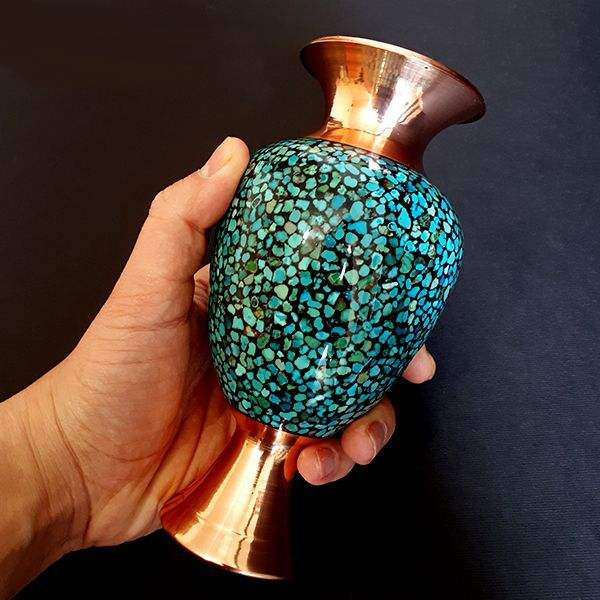
How artists create artwork by using turquoise Inlaying technics
Turquoise Inlaying art crafts contains two material:
1. metal: For the metal part of this artwork, we can use gemstones, the copper, brass, and silver. Today copper and silver are respectively used for vessels and accessories.
2. stone: The stone used in this art crafts is turquoise, one of the most in-demand gemstones in the world which is extracted from turquoise mines in Neishabur that is famous for its high-quality turquoises.
IRAN ART EXHIBITION: In fact, Turquoise Inlaying is kind of similar to mosaic art since the stones are stuck to the metal base with such a specific precision and sensitivity. After the first process then they will be polished in several steps in order to have the final product. Finally, the polyester cover is used to make the vessels more bright. It gives a minimum of 10 years warranty of brightness and polish of the art craft.
Short maintenance tips:
The maintenance is very easy. It requires wiping to make it clean and as bright and beautiful as new. The vessels that are more functional may lose their cover. In this case, you can easily clean it by vinegar and salt to make it brighter and polished.

